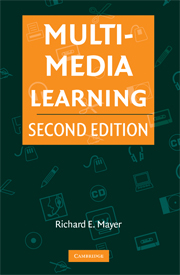Book contents
- Frontmatter
- Contents
- PREFACE
- SECTION I INTRODUCTION TO MULTIMEDIA LEARNING
- SECTION II PRINCIPLES FOR REDUCING EXTRANEOUS PROCESSING IN MULTIMEDIA LEARNING
- 4 Coherence Principle
- 5 Signaling Principle
- 6 Redundancy Principle
- 7 Spatial Contiguity Principle
- 8 Temporal Contiguity Principle
- SECTION III Principles for Managing Essential Processing in Multimedia Learning
- SECTION IV PRINCIPLES FOR FOSTERING GENERATIVE PROCESSING IN MULTIMEDIA LEARNING
- SECTION V CONCLUSION
- REFERENCES
- AUTHOR INDEX
- SUBJECT INDEX
- References
8 - Temporal Contiguity Principle
- Frontmatter
- Contents
- PREFACE
- SECTION I INTRODUCTION TO MULTIMEDIA LEARNING
- SECTION II PRINCIPLES FOR REDUCING EXTRANEOUS PROCESSING IN MULTIMEDIA LEARNING
- 4 Coherence Principle
- 5 Signaling Principle
- 6 Redundancy Principle
- 7 Spatial Contiguity Principle
- 8 Temporal Contiguity Principle
- SECTION III Principles for Managing Essential Processing in Multimedia Learning
- SECTION IV PRINCIPLES FOR FOSTERING GENERATIVE PROCESSING IN MULTIMEDIA LEARNING
- SECTION V CONCLUSION
- REFERENCES
- AUTHOR INDEX
- SUBJECT INDEX
- References
Summary
Temporal Contiguity Principle: Students learn better when corresponding words and pictures are presented simultaneously rather than successively.
Example: The learner first views an animation on lightning formation and then hears the corresponding narration, or vice versa (successive group), or the learner views an animation and hears the corresponding narration at the same time (simultaneous group).
Theoretical Rationale: When corresponding portions of narration and animation are presented at the same time, the learner is more likely to be able to hold mental representations of both in working memory at the same time, and thus, the learner is more likely to be able to build mental connections between verbal and visual representations. When corresponding portions of narration and animation are separated in time, the learner is less likely to be able to hold mental representations of both in working memory at the same time, and thus, the learner is less likely to be able to build mental connections between verbal and visual representations.
Empirical Rationale: In eight out of eight tests, learners performed better on transfer tests when corresponding portions of animation and narration were presented simultaneously rather than successively. The median effect size is d = 1.31.
Boundary Conditions: The temporal contiguity principle may be less applicable when the successive lesson involves alternations between short segments rather than a long continuous presentation or when the lesson is under learner control rather than under system control.
- Type
- Chapter
- Information
- Multimedia Learning , pp. 153 - 170Publisher: Cambridge University PressPrint publication year: 2009
References
- 1
- Cited by



